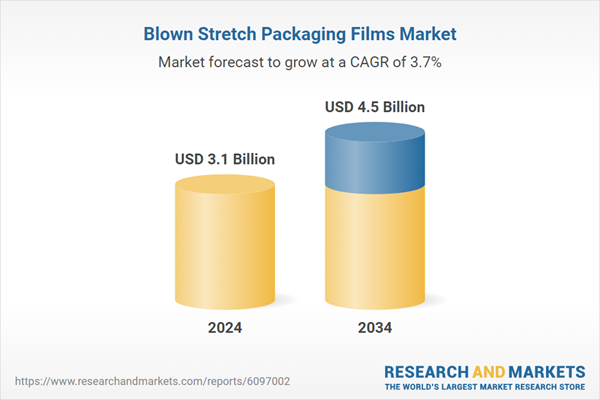Material type plays a vital role in the market's evolution. Linear Low-Density Polyethylene (LLDPE) holds a significant portion of the market due to its outstanding mechanical properties, such as higher tensile strength, flexibility, and puncture resistance. These features make LLDPE a preferred choice for stretch film manufacturing, especially when thinner films are required to reduce material usage without compromising durability. The LLDPE segment is forecast to grow at a CAGR of 4.1% by 2034, reflecting the rising preference for high-performance and cost-efficient packaging solutions in sectors like logistics and consumer goods.
In terms of product types, the market includes hand stretch films, machine stretch films, and specialty variants. Among these, hand stretch films are gaining traction due to their cost-effectiveness and versatility. The hand stretch film segment is projected to reach USD 2.4 billion by 2034, fueled by increasing usage among small to medium businesses and warehousing operations that rely on manual wrapping. These films provide a practical solution for low-volume packaging needs, especially in markets with minimal automation infrastructure.
Thickness is another key parameter influencing demand. Films with up to 20 microns in thickness accounted for a market share of 43.3% in 2024. This segment is expanding as more industries turn to thinner films to wrap lighter goods. The preference for lower thickness helps reduce packaging waste, cut transportation costs, and support sustainability efforts, which are increasingly important in modern supply chains.
The end-use industry segmentation shows a dominant presence in the food and beverage sector, which held a 38.5% market share in 2024. Blown stretch films serve a crucial role in this industry by offering protection against moisture and physical damage, extending product shelf life. Their ability to support secure and hygienic packaging during storage and transit makes them highly suitable for perishable goods. As consumers increasingly demand safe and convenient packaging, the adoption of blown stretch films continues to rise in this sector.
Distribution channels also shape the market dynamics, with direct sales leading the way by accounting for 52% of the total share in 2024. Direct sales allow manufacturers to provide customized packaging solutions tailored to specific customer requirements such as film thickness, tensile strength, or visual attributes. This approach strengthens client relationships and enables seamless communication, ensuring better service and product support.
In the regional landscape, the United States is expected to witness strong growth, with its market projected to hit USD 600 million by 2034. The demand for high-performance food packaging materials is rising, particularly due to expanding e-commerce and increased consumer expectations for safe and efficient product delivery. As a result, the market is seeing increased innovation in packaging solutions to ensure product integrity and support growing logistical needs.
The competitive environment in the blown stretch packaging films market remains intense, with leading players competing on quality, innovation, and sustainability. Companies are heavily investing in developing biodegradable and multi-layer film technologies to meet environmental standards and consumer preferences. In addition, firms are focusing on strategic mergers, acquisitions, and regional expansions to strengthen their market presence and improve technological capabilities. There is also growing interest in smart packaging solutions, including RFID integration and temperature monitoring, to enhance supply chain efficiency and ensure safety. Customization for targeted industries like pharmaceuticals, logistics, and consumer goods is becoming increasingly important as a differentiating factor in this evolving market.
Comprehensive Market Analysis and Forecast
- Industry trends, key growth drivers, challenges, future opportunities, and regulatory landscape
- Competitive landscape with Porter’s Five Forces and PESTEL analysis
- Market size, segmentation, and regional forecasts
- In-depth company profiles, business strategies, financial insights, and SWOT analysis
This product will be delivered within 2-4 business days.
Table of Contents
Companies Mentioned
The companies featured in this Blown Stretch Packaging Films market report include:- Berry Global Inc.
- AEP Industries Inc.
- Amcor Plc
- Coveris Holdings S.A.
- DUO PLAST AG
- Eurofilms Extrusion Ltd
- FlexSol Packaging Corp.
- Integrated Packaging Group Pty Ltd
- Intertape Polymer Group Inc.
- Manuli Stretch S.p.A.
- Megaplast India Pvt. Ltd.
- Mondi Group
- Paragon Films Inc.
- Polifilm GmbH
- RKW Group
- Sealed Air Corporation
- Sigma Plastics Group
- Trioplast Industrier AB
Table Information
| Report Attribute | Details |
|---|---|
| No. of Pages | 180 |
| Published | May 2025 |
| Forecast Period | 2024 - 2034 |
| Estimated Market Value ( USD | $ 3.1 Billion |
| Forecasted Market Value ( USD | $ 4.5 Billion |
| Compound Annual Growth Rate | 3.7% |
| Regions Covered | Global |
| No. of Companies Mentioned | 19 |









